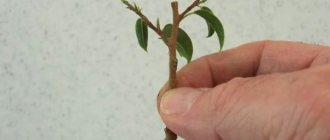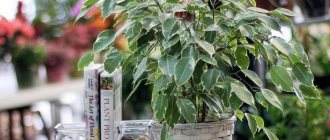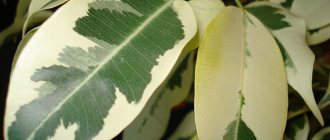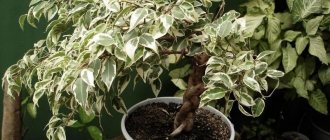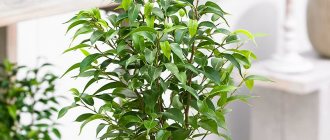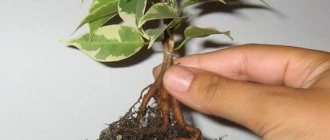Why is weaving done?
Ficus benjamina is intertwined not only for the sake of the plant’s attractiveness, although this is also one of the goals of this procedure. Additional weaving tasks:
- ficus trees grow quickly. In order not to worry about increasing the growth of the stem, and not to construct awkward supports, you need to decorate it;
- the beautiful shapes of the flower trunk will fit perfectly into any composition of a small or large greenhouse;
- Those who like to tinker with indoor plants can pay a lot of attention to this kind of care.
Ficus in the interior
The main purpose of weaving is determined by the needs of the grower.
Necessary materials
Having selected an option for your future creation, you need to prepare the necessary equipment and materials for the work. In addition, you cannot do without step-by-step instructions for making a bonsai tree with a detailed description of the steps.
First of all, prepare the necessary materials and tools: multi-colored beads, special wire (thin and thick), thread for braiding the trunk and branches, plaster or alabaster solution (to create reliable support), acrylic paint, container of the desired shape, decorative elements, glue moment, cellophane film, wire cutters, brush and gloves to protect your hands.
Types of ficus weaving
Pruning ficus benjamina at home
There are several options for ficus weaving, the choice depends on the preparation of the plant itself. There are several options for how to weave ficus.
Spiral
The most popular and simplest option for arranging a flowerpot with a beautiful ficus composition. Circular weaving is simple but effective. Produced by braiding a support. As it grows, the stem is bent along the contour of the selected base. After fixing the shape of the trunk, the support can be removed.
Spiral from the trunk
Hedge
This version of the composition is complex. First you need to plant the seedlings in a row. Next, the stems can be intertwined with each other according to different types.
Note! Honeycombs, diamonds, and ovals are often used.
Hedge
Pigtail
To weave a braid from Benjamin's trunk, you need to wait until the thickness of each seedling reaches 1 cm. Next, weaving is done according to the principle of how hair strands are folded.
Pigtail
Column
The difficulty may lie in merging adjacent trunks. Inexperienced gardeners can damage the flower too much, which can lead to the death of the specimen.
Column
Important! For each weaving option, an individual form of planting seedlings is produced. A beginner can handle spiral and braid weaving, but forming a hedge is more difficult. It is necessary not only to build the correct support, but also to splice the elements together.
Lattice
Lattice is considered an interesting type of weaving. To recreate this form you need to have 6 or 8 seedlings. To braid Ficus Benjamin with a classic lattice, an even number of shoots is a prerequisite. Next you need to cross all the stems of the flower. To do this, you can use a wide tube made of plastic or cardboard. You need to install it in the middle of the pot and start braiding it in a circle. In this case, the lattice will be closed. Sometimes you can plant another flower in the middle, like a ficus. The main thing is to maintain the distance for the roots.
To recreate a trellis like a small fence, the sprouts should be planted evenly spaced in a single row. Crossing of trunks occurs by artificial fixation with threads or wire. Metal can damage the delicate stems of the plant, so you should wrap it with extreme caution. Before braiding the decorative ficus Benjamin with a lattice-fence, you can rub the tying areas with paraffin.
Sometimes a coconut pole is used to create an abstract flower appearance. Young ficus shoots are planted in a circle from the support and the side shoots are removed. After some time, the plant itself will choose how to grow and can weave itself into bizarre shapes. The increased humidity from the coconut pole has a beneficial effect on the flower, so the stems will quickly grow and can grow together without additional measures.
How to prepare a plant
Transplanting Ficus Benjamin at home
In order to braid the trunk of a houseplant in the future according to the chosen pattern, it is worth preparing the seedlings correctly. This applies to planting, care, and weave formation. You can only braid the trunk of a young seedling, so you need to plant the sprouts, and then dull them for gradual processing. Stages of plant preparation:
- The trunk can be intertwined until the sprout reaches more than 10 cm in height. With a gradual increase in the plant, it is possible to splice adjacent trunks in accordance with a certain technology.
- To create an individual composition, you should use at least three seedlings. But it is better to plant more than five in one pot. For planting, it is recommended to use a container with a large diameter. It is preferable to use a square or round tub. The size of the container directly depends on the number of copies.
- It is worth creating compositions from shoots that have the same stem diameter. Otherwise, the final picture will look sloppy. To avoid the growth of one specimen and the depletion of another, you need to do the same watering, fertilizing and pruning.
- The seedlings need to be planted in March in order to begin the ficus weaving procedure in mid-May. Prepare soil rich in microelements and place a drainage layer on the bottom of the pot.
Principle of plant preparation
Note! Additionally, the trunks can be spliced as the ficus grows and develops. It is necessary to cut off parts of the already lignified trunks and press them tightly against each other.
If one of the plant preparation factors is not taken into account, the trunks will not intertwine, or the composition will turn out sloppy.
Lattice
The lattice is considered a more complex method of weaving, but despite this, the beauty of the resulting specimen can be envied. It is worth paying attention to the fact that the classic lattice implies the presence of eight ficus trees. True, considering that not everyone’s territory allows them to buy a large pot and allocate a separate corner for it, you can use any number of plants, but their number must be even.
The steps for creating a lattice are as follows:
- Young shoots are planted in a flowerpot under one line, clearly measuring the distance from one cutting to another. Violation of this nuance will entail a deviation from the norm, and the weaving will no longer look so aesthetically pleasing.
- When the stems reach a certain height (10-12 cm), they need to be intertwined. Cardboard tubes that need to be installed in the center are suitable for these purposes.
- After some time, the young bushes are directed in the direction the gardener wants. The lattice does not have to be smooth; it can have an unusual bend, which will give the whole structure a special twist. The main thing in this matter is imagination, so you shouldn’t push it into the background. To achieve the desired result, you can use a wire with a winding, which can then be easily removed.
Important! The fixation should not be too strong so as not to damage the ficus.
Some gardeners create a trellis in a different way. It is simple, but at the same time original. For these purposes, you need to take a coconut stem and plant it in the center of the flowerpot. Considering that such a trunk has high humidity, the aerial roots of the ficus will begin to actively develop, quickly intertwining with each other.
However, it should be remembered that young shoots need to be planted around the coconut trunk at a short distance. In this case, the ficus should not have side shoots. After a while, you will notice that the layers are intertwined with each other, creating a special composition. By the way, many gardeners, wanting to get something unusual without damaging the plant, prefer this method.
How to weave a ficus
How to care for ficus benjamina in a pot at home
To intertwine plant stems, you need to know some rules. There are several basic ones that relate to carrying out the procedure at an almost professional level:
- regardless of which weaving option will be used, you need to plant the seeds at a distance of 3-5 cm from each other;
- to make the trunk even more pliable and soft, you need to water it 12 hours before the procedure;
- During the growth process, you need to trim off the side shoots. The crown is formed at the very top;
- during work, you can control the force of weaving, evenly positioning each element of the composition. To achieve this, it is advisable to prepare a base frame;
- then you need to carefully lay the flexible stems according to a given pattern. If necessary, threads can become temporary fixation;
- Braiding must be done carefully so as not to overtighten the plant. Otherwise, the sprouts may die due to improper circulation of juice. The threads are applied at an angle of 45°.
Features of splicing
Important! The ficus grows quickly, but still it is necessary to start forming a new weaving element no earlier than after two months.
Pigtail
A braid is a type of complicated spiral. This circular weave requires special fixation. The sprouts themselves should not exceed 2 cm. Stages of the braiding procedure:
- Flowers of the same height are planted in a separate pot. The number of seedlings can vary from 3 to 5.
- Before starting weaving, you should thoroughly water the flower and remove excess shoots. Leaves at the top of the flower are allowed.
- After waiting 12 hours, you can begin to weave the plant. After watering, the ficus stems become more flexible, which allows you to weave the desired shape.
- Once the desired shape has been achieved, the stems must be secured with thread.
It may take six months to form such a shape, during which time the plant should be braided. If you want to get a flower with a fused trunk in the shape of a pigtail, then you need to trim the bark at the points of contact of the 2 shoots. After some time, the stems will grow together. To create holes in the trunk of a plant, experts recommend inserting ordinary wooden pencils. Thus, the holes will be the same and form a unique pattern.
Treatment of plant trunk
To make the weaving seem more attractive, you need to form the correct crown. To do this, trim off excess sprouts and shoots. If this is not done, the leaves will begin to weigh down the shoots and bend down.
For your information! If you do this correctly, the flower will develop normally, but additional processing is also needed.
How to trim
You cannot cut more than five branches at a time. The cut site must be treated with an antiseptic or activated carbon powder. Do not use too much product to cover exposed areas.
How to plant a flower so that the stems intertwine?
To create a minimal structure, you need to take at least three cuttings. To get a more interesting picture you will need a little more shoots.
To form a more interesting design, you should take enough seedlings to completely fill the future composition.
Shoots are selected of the same diameter so as not to spoil the overall decorative picture
It is especially important to follow this rule when creating a braid or circular weave.
It is best to plant stems in the first months of spring. This will allow them to develop much faster. And in a month you can start experimenting with creating decorative compositions.
If you plan to splice trunks, then it is better to take shoots not 10 cm, but 15, since thin bark already appears on such seedlings. During the growing process, the bark should be regularly trimmed in places where the trunks meet. This must be done very carefully so as not to harm the plant.
The choice of pot in which the composition will be created needs to be given special attention. To place a hedge, you will need a wide container with high walls of a rectangular or oval shape.
For a braid or spiral, a regular pot will do. In addition, one should not forget about the number of sprouts used - this also affects the size of the container.
- brick chips;
- pebbles;
- expanded clay;
- artificial stones.
The height of the drainage layer depends on the height of the pot.
Important! Roots of cuttings that are too long or damaged need to be trimmed. The soil mixture for ficus should consist of peat, sand and leaf soil
You can buy it in specialized stores or prepare it yourself. You need to pour half of the prepared soil onto the drainage. The cutting should be placed so that the root collar is above the ground surface. The roots must be straightened and sprinkled with soil.
The soil mixture for ficus should consist of peat, sand and leaf soil. You can buy it in specialized stores or prepare it yourself. You need to pour half of the prepared soil onto the drainage. The cutting should be placed so that the root collar is above the ground surface. The roots must be straightened and sprinkled with soil.
Leave a gap of several centimeters between the soil and the edge of the pot.
After planting, the soil should be sprinkled with warm water with the addition of growth stimulants. The first feeding is carried out 3–4 weeks after the seedlings take root.
Further flower care
It is not enough to plant a flower correctly and decorate the trunk beautifully; you also need to take care of the ficus. The plant loves abundant watering and spraying of the crown. Therefore, it is important to wipe the leaves with a damp cloth at least once a week.
Caring for intertwined ficus
Braided trunks must be constantly inspected for damaged areas, the tightening force of the threads, and the principle of bending the trunks must be checked. The plant should be placed in partial shade to prevent the leaves from wilting.
You can decorate your home with a completely unique flower, creating a beautiful composition by intertwining the trunks of several ficus trees. The Benjamin variety is suitable for this. The principle of creating figures from plants is carried out thanks to the correct crease and bend of the trunk.
XXI CENTURY Candy Fudge Scented water
266 ₽ More details
Video baby monitor Motorola MBP36S (white)
12900 ₽ More details
Maternity raincoats
Rules for keeping ficus at home
Before any manipulation, you need to make sure that the plant is healthy and the new environment is suitable for it. To make your green friend comfortable, it is necessary to create certain conditions:
- After purchasing, it would be useful to pay attention to the condition of the foliage. Sometimes, to give additional brightness, the leaves are rubbed with chemical products. To help the flower, it is better to use a wet napkin.
- Ficus is conservative by nature. He does not like change, so you need to immediately decide on his location. The plant hates changes and can get sick from stress, changing its blooming appearance to a fading one.
- A flower needs excellent lighting; without it, growth and development does not occur. How to weave a ficus if there is no growth? He will be grateful for placement on a spacious window sill facing the east side. In winter, when the sun does not indulge in its rays, the ficus should be additionally illuminated.
- The plant loves abundant watering. To prevent the rays from drying out the trunk, it is necessary to monitor the condition of the soil.
- An open balcony is not suitable as a permanent home for a capricious handsome man. It does not tolerate drafts and rain well, so it is better to place it indoors.
- The temperature should not be higher than 15°C. It is better to avoid temperature fluctuations.
- Such a plant has a need for water treatments. Once a month you need to wash with warm water. Before placing it in open light, be sure to thoroughly dry the leaves and crown.
- A demanding pet cannot tolerate dry air. If the room has low humidity, you can spray it with a spray bottle.
Diseases and pests
Sometimes the plant can get sick - its leaves become covered with blisters, which then begin to peel off.
This disease cannot be treated, and the plant must be destroyed.
There may also be blisters on the leaves that turn yellow-brown in color.
The most common pests are:
- Mealyworm.
- Spider flare.
- Shield.
- Aphid.
You can read more about diseases and pests of Ficus Benjamin here.
How to root shoots?
Rooting of shoots can be done in several ways:
- Using a container with warm water. It only covers the nodes of the plant. It is also important to create high humidity, so covering it with a bag or jar is a good idea.
- Lowering the cuttings into the substrate. Sand or peat can be used as a substrate. It should be sufficiently moist or warm. Immediately before planting the shoot in it, the soil is sprinkled with an activated carbon tablet. The substrate should be moist, but not soggy.
- Rooting of aerial shoots. To do this, make 2 cuts between them, and then remove the bark from the tree.
Rules and methods of weaving ficus Benjamin
Today you will not surprise anyone with an interesting plant called bonsai. It is quite common in various stores and greenhouses. Looking at this amazing composition, thoughts come to mind: how can you form it yourself? Weaving Ficus Benjamin must be carried out according to special rules.
After searching for information, you can see that this is done by human hands. However, the difficulty is that violation of the weaving technique can negatively affect not only the aesthetics of the finished composition, but also the health of the plant itself. To avoid such mistakes, you should carefully familiarize yourself with the secrets of forming Ficus Benjamin at home.
Rules for weaving ficus benjamina
In order to give the plants an original shape, several young ficus plants (at least three pieces) should be placed in one wide container. Their size should be approximately the same, and their height should not exceed 10 cm. However, they should not be completely covered with bark, which contributes to the loss of elasticity.
As plants develop and mature, we can regulate their shape by timely pruning the crown, as well as by setting the branches in the required direction of growth.
However, if you want to get a spiral shape of intertwining ficuses, two copies will be enough for this, but still, the greater the number of ficuses involved in the composition, the more spectacular it will be in the end.
Rooted shoots are ready to form after they reach a length of 10 cm. In the process of weaving Ficus Benjamin at home, each subsequent turn is made as it grows. At the beginning of formation, you can use wool or other soft thread, which will fix the required shape. As the trunks grow, the thread will also need to be moved.
Usually between each revolution there is a time interval that is equal to two months. There are often situations when, when rewinding the thread, a white liquid appears on the surface of the plant, which means that the integrity of the bark is damaged (you have pulled the thread somewhere).
However, this is not scary, just next time when weaving a ficus, stick to an angle of 45°. As the trees develop, when the braid is already high enough, additional support should be installed so that the composition turns out strictly vertical.
Spiral and hedge
These options are nothing more than the usual circular weaving of ficus Benjamin. From an aesthetic point of view, this method looks no worse than the others, and quite often attracts the eye.
In addition, this type of trunk formation is much simpler than other options.
To give plants a spiral shape or create a hedge, you should follow a certain sequence.
After the bush is fully formed and stops growing, the support is removed. However, you should not rush into this, since a weak trunk may bend, which will not have the best effect on the appearance of the composition. The main task of a florist creating compositions from plants is weaving trunks, but subsequent care of the plant is no less important.
The remaining ficus shoots can be planted in such a way that it is easier to give the trunks the shape of a hedge. This is quite a difficult task, but the resulting effect will exceed even the wildest expectations.
Plant small ficus shoots in one container, keeping the same distance between them. Weaving can be started in any order and even chaotically, repeating the turns as the trunks grow. This method is called linear.
You can also come up with your own original way. Sometimes you come across such original compositions in which the trunks are twisted so intricately that you simply cannot believe that it was made by human hands, and besides, it is completely unclear where and what sprout originates.
We invite you to watch a video about ficus weaving:
https://www..com/watch?v=L7KD1MWYF-Y
Ficus crown formation
- The ficus produces new shoots from the buds, the activity of which depends on the location. The upper buds give rapid growth; this must be taken into account when forming the ficus crown.
- Not every ficus can be shaped the way you want, since each species has its own shape by nature. The Ficus Benjamin bushes on its own, but the Rubber Ficus shoots upward, shedding its lower leaves, and you will have to work hard to form its crown.
- It is very important at what period you prune the ficus. If you cut off the top shoot in winter, only one of the side shoots may have enough strength for new growth, and your ficus will grow one-sided. If you prune in the spring, the ficus has enough strength and time to grow evenly in all directions that you can stimulate.
- The formation of a ficus trunk is easier to do in young plants. An adult plant no longer has the necessary flexibility and can ruin your experiment before you ruin the ficus.
- You need to cut the shoot above the bud. If the shoot is thick, the cut should be oblique.
- If the apartment has high humidity, aerial roots may periodically appear on the ficus. Help them reach the goal, guide them into the soil.
Depending on the type of ficus, you can shape its crown in different ways: bush, trunk, arc, bonsai. More complex forms relate to sculptures and ficus weaving.


